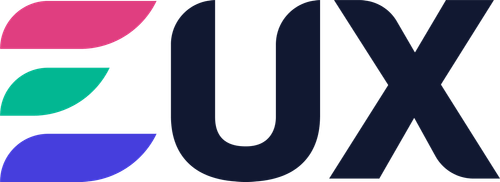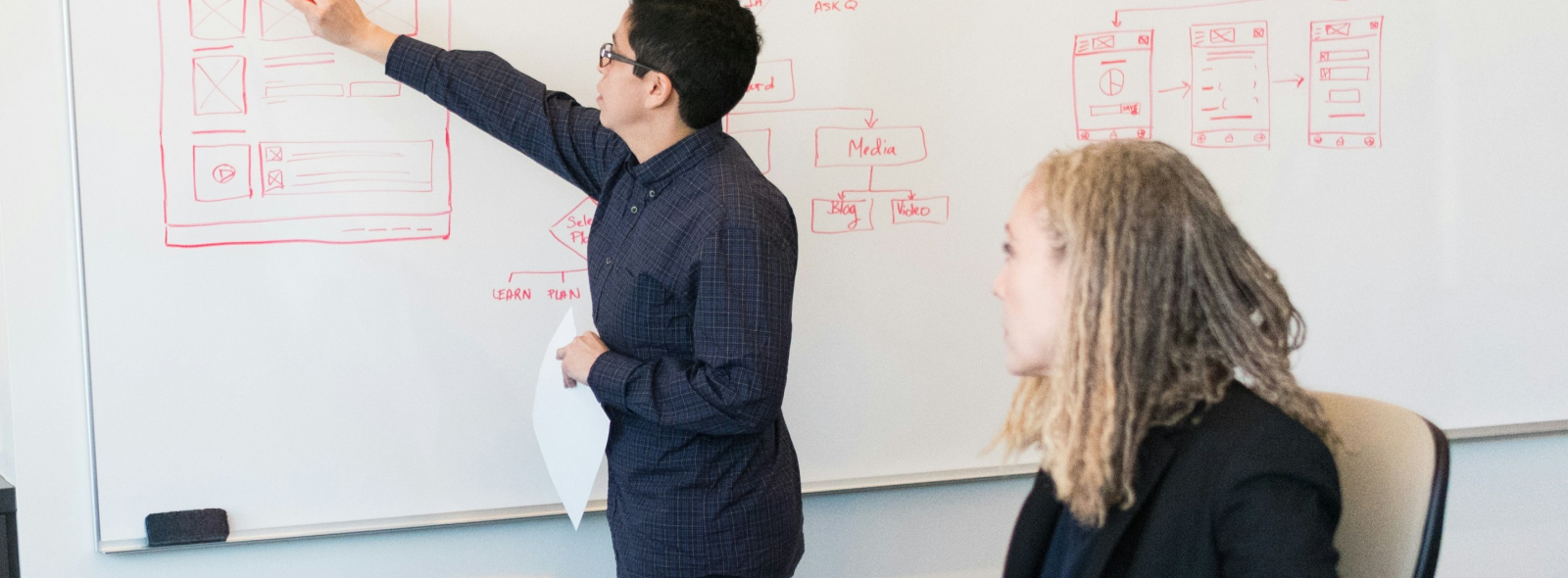Ever tried to navigate a labyrinth with no map? That’s what it feels like when you dive into the world of Enterprise UX Design without understanding its fundamentals. Fear not – this labyrinth can be navigated with confidence.
In this exploration, we’re going on an exciting journey together, unraveling these intricate paths and turning confusion into clarity. You’ll learn about the importance of balancing business goals with user needs, and how crucial feedback is for refining designs iteratively.
We’ll delve deeper into mapping user journeys within enterprise applications and address those steep learning curves that so many fear. And yes, there will be challenges – but rest assured we’ve got solutions up our sleeves!
Ready for this adventure? Strap in because things are about to get interesting! The power of great Enterprise UX design awaits us…
What is Enterprise UX Design?
The world of enterprise UX design is a complex landscape, shaped by the demands and challenges of large organizations. The process involves designing for professionals who interact with intricate B2B solutions daily.
A key distinction to make here: enterprise UX isn’t just about making software look good. It’s about devising an interface that facilitates users’ daily operations, thus augmenting their efficiency in the long run.
UX design as a whole, including its enterprise variant, is rooted in understanding user needs and crafting solutions accordingly. This principle holds even more significance when applied to enterprise settings where stakes are higher and complexity abounds.
The Role of UX Designers in Enterprise Settings
In any setting, UX designers play a pivotal role; however, within enterprises this role becomes especially crucial. They act as advocates for users within businesses while aligning product development with business goals.
Beyond simply ensuring an appealing interface or seamless navigation flow – although these aspects are important – they dive deep into solving problems faced by actual users on a day-to-day basis. For example, how can we minimize steep learning curves? How can our design put employee productivity first?
Facing up to Bad User Experience (Bad UX)
Sadly enough, ‘bad ux’, characterized by confusing interfaces and convoluted workflows, is quite common in many legacy enterprise applications used today. These applications often result from years of feature additions without adequate attention paid towards holistic user journey optimization. This leaves us with one critical question: How can we make UX better in such complex enterprise scenarios?
It’s here that a well-thought-out ‘UX design process’ comes into play. This process involves empathizing with users, defining their problems, ideating solutions, prototyping, and testing the designs before final implementation.
The Evolution towards Great UX
The good news is clear as day.
Key Takeaway: Enterprise UX design isn’t just about pretty software. It’s making users’ tasks easier, boosting their productivity. UX designers in enterprise settings dive deep into problem-solving, focusing on employee efficiency and aligning with business goals. To improve complex scenarios marked by bad user experiences (UX), a thoughtful process of empathizing with the users, defining problems clearly, brainstorming innovative solutions, and developing effective prototypes is key.
Principles Guiding Enterprise UX Design
At the heart of enterprise UX design lie some key principles that help strike a balance between business goals and user needs. These guiding stars make sure the designs are empathetic, strategic, usable, inclusive, and validated.
Balancing Business Goals with User Needs
In designing an enterprise application, it’s crucial to align business objectives with user requirements. But why? To create an effective application, it’s essential to consider both the user needs and business objectives; otherwise, any features included may be irrelevant or difficult to use.
To create a win-win scenario for both parties involved – businesses aiming for success and users looking for solutions – you need empathy as your first tool. Empathy lets designers step into users’ shoes; understanding their pain points which ultimately helps shape better design solutions.
The Strategy Aspect of Enterprise UX Design
A successful UX design process is more than just aesthetics—it involves strategy too. Strategic thinking means foreseeing potential issues down the line or identifying opportunities early on—ultimately leading to better product development.
A strong UX strategy ensures that even while innovating, one must tread carefully considering competition. The landscape of software design changes rapidly; thus keeping abreast of these shifts allows enterprises to stay ahead in the game without losing sight of usability—the essence behind any great UX.
Inclusivity Matters Too
If we’re talking about principles guiding enterprise UX design then let’s not forget inclusivity. Inclusive designs do not exclude anyone based on ability or situation—making them accessible for everyone across different devices or contexts. The goal here is to cater for the widest possible audience, thus maximizing employee productivity.
Usability: A Non-Negotiable Principle
After all, bad UX often results in unhappy users who may abandon your product or service. It is paramount to prioritize usability from the beginning, guaranteeing a smooth and enjoyable experience for all.
Key Takeaway: platforms. Usability, on the other hand, focuses on making sure that everyone can use your app without any hitches. Balancing these principles effectively is essential for designing an enterprise application that truly serves its users and supports business objectives.
Journey Mapping in Enterprise UX Design
Mapping user journeys within enterprise applications is like a game of chess. You need to think several moves ahead, considering each possible decision your users could make. This process involves understanding their goals and motivations, but also the potential learning curves they may encounter.
One way we do this at our UX agency is by creating an interface that demands some level of learning from its users. Now you might be thinking: “Isn’t good UX supposed to be intuitive?”. That’s true for consumer apps where simplicity rules supreme. But when it comes to complex enterprise software solutions, there’s a twist.
The goal isn’t always about making tasks as easy as possible; sometimes it’s more important to provide powerful functionality that can boost productivity after initial training. Here is an interesting article explaining how increased productivity can justify steeper learning curves in these cases.
The Importance of Non-linear Flows
In consumer-facing apps, linear flows guide users through predefined steps towards a single end-goal. However, with User Journey Mapping in Enterprise Applications, things are different. Users aren’t casual consumers looking for simple answers – they’re professionals seeking flexibility and control over their workflow.
This means we need non-linear flows that allow them freedom while using the platform according to their specific needs or preferences. “Addressing Learning Curves in Enterprise Software” becomes crucial here as well – allowing employees not only to grasp new systems faster but also to use them effectively on a day-to-day basis.
Focusing on Actual User Tasks
We must focus on the actual tasks the user performs. These tasks may range from daily activities to more complex ones that require advanced features of the software.
The process involves observing and understanding users, their motivations, limitations, and how they complete tasks in real-world scenarios. We also take into account their expectations about using enterprise applications – it’s a journey that goes beyond simple wireframes or design principles.
Key Takeaway: Enterprise UX design is a chess-like game where user journeys require thoughtful planning. It’s not always about simplicity, but rather powerful functionality that boosts productivity after initial learning. Users crave flexibility and control over their workflow, demanding non-linear flows in enterprise applications. Also crucial is understanding the real-world tasks users perform – considering motivations, limitations, and expectations beyond basic design principles.
Overcoming Challenges in Enterprise UX Design
Navigating the realm of enterprise UX design can feel like trekking through a dense forest. You’ve got your compass (the user’s needs), your map (business goals), and your backpack full of tools (design principles). Despite the preparedness, you may still face an unforeseen hurdle in your journey. Let’s discuss some common challenges in enterprise applications, along with practical solutions to conquer them.
The Beast Known as Complexity
Enterprise software is notorious for its complexity. A result of multifaceted business processes it aims to streamline, this complexity often leads to bad UX – a fact surprisingly accepted by many users who are accustomed to convoluted interfaces and steep learning curves.
In such cases, embracing simplicity may seem tempting but remember – we’re dealing with large companies where intricate tasks are performed on a day-to-day basis. So instead of dumbing down complex features, focus on making sure they work seamlessly and intuitively for actual users while keeping employee productivity high.
Read: Enterprise UX Design: Challenges and Best Practices Explored
Facing Technical Limitations Head-on
Sometimes constraints aren’t just about what the user wants or how business operates; technical limitations push designers into tight corners too. These could be existing legacy systems that resist change or restrictive development frameworks hindering creativity.
To overcome these obstacles without compromising usability or functionality requires flexibility from both designers and developers alike — not unlike seasoned explorers adjusting their route when faced with an unscalable cliff. Good UX thrives within limitations if approached strategically.
Tackling Common UI Pitfalls
Many enterprise UX designers struggle with the task of creating interfaces that are straightforward and easy to maneuver while also granting access to intricate features. For instance, common issues like misplaced menus or cryptic icons can confuse users and create bad UX.
the line. Getting insights from real users can highlight any UI issues early on, which saves time and prevents headaches later. Don’t disregard the potency of user remarks; it’s a beneficial asset in honing your plans.
Read: UX Design Agency vs In-house UX Team: Cost-Benefit Analysis
Key Takeaway: Enterprise UX design is like a challenging hike, with users’ needs as the compass and business goals as the map. Tackling complexity isn’t about oversimplifying but making intricate tasks intuitive. Overcoming technical limitations demands flexibility from designers and developers alike, while common UI pitfalls can be fixed by getting early user feedback.
The Role of Designers in Enterprise Software Development
UX designers play a crucial role in the development of enterprise software. They help strategize, research, and collaborate to ensure that user needs are met effectively.
Collaboration: A Key for Success
A successful design team relies heavily on collaboration. UX creators collaborate with coders, project directors, and other stakeholders to ensure their designs fit technical capacities and business objectives.
They use wireframes and prototypes as communication tools to visualize complex processes. These visual aids allow them to present their ideas clearly while promoting mutual understanding within the team.
The Strategic Role of Designers
Beyond creating beautiful interfaces, UX designers also contribute significantly at a strategic level. They understand both the company’s objectives and users’ expectations; hence they can create designs that serve both ends well.
This involves empathizing with users through conducting user research, creating personas based on actual users data or even going out into field studies observing how end-users interact with current systems. Yes, they often become private detectives searching for clues about what would make a product truly great.
User Research: The Cornerstone of Good Design
Informed decisions stem from good user research. This process allows designers to learn about user behaviors, motivations, pain points – essentially anything that could impact how they might interact with an enterprise app or platform.
- User testing is one such technique used by UX teams where real-life scenarios are created for potential users who complete tasks while designers observe their interaction.
- Software Usability testing is another tool where users interact with a prototype or existing product to evaluate its ease of use, and designers fix identified issues before the final product release.
Fun fact: there’s an increasing demand for UX designers due to their broad usefulness. Their skills can boost company productivity and even improve people’s quality of life.
Key Takeaway: UX designers are the secret agents of enterprise software development, diving deep into user research and strategy while collaborating with various teams. They use tools like wireframes and prototypes to visualize ideas, ensuring that designs meet both business goals and user needs. By fixing issues through usability testing before product release, they’re key in boosting company productivity and enhancing people’s lives.
Career Opportunities and Growth in Enterprise UX Design
Enterprise UX design offers a promising career path with plenty of room for growth. As companies realize the impact good user experience can have on employee productivity, they are increasingly investing in this field.
Job Prospects
The demand for skilled enterprise UX designers is rising steadily. Large companies often require complex software solutions tailored to their unique business processes, creating a constant need for professionals who understand users’ goals and expectations.
This makes the role of an enterprise UX designer not only vital but also diverse. They work closely with stakeholders to align product development strategies with user needs while navigating technical limitations.
Necessary Skills
To succeed as an enterprise UX designer, you’ll need more than just creativity or coding skills; it’s about understanding both people and systems. Discovering user needs and designing solutions that meet them requires empathy and analytical thinking.
You should be able to create wireframes, conduct usability testing, interpret feedback from actual users, manage steep learning curves inherent in large-scale applications—all these while ensuring designs meet specific business goals without compromising on positive experiences for end-users.
Growth Potential
The future trends point towards a surge in opportunities within the realm of enterprise design. A growing emphasis on improving software design directly translates into higher job prospects for aspiring designers willing to solve problems faced by enterprises daily.
A career choice here isn’t just about securing employment; it’s about having meaningful impacts—making complex processes simpler and helping businesses become more efficient through better-designed software tools. Remember: great UX equals happy employees.
Learning Opportunities for Aspiring Designers
If you aspire to enter this domain, there are numerous resources available. Many online platforms offer courses that can help you learn UX design principles and strategies.
Remember, theory alone won’t cut it; hands-on experience is priceless. Keep an eye out for internships or actual tasks where you can apply your skills.
Key Takeaway: It’s a booming field, combining creativity with empathy and analytical prowess. As companies start to understand how great user experience boosts productivity, the doors are opening wider for enterprise UX design professionals. Skills such as wireframing, usability testing, and interpreting feedback need to be mastered alongside aligning designs with business objectives. So why wait? There’s a wealth of resources available that can teach you key principles and strategies.
Read: Revolutionizing Enterprise UX Design: The Intersection of AI
Best Practices for Effective Enterprise UX Design
To boost the effectiveness of enterprise user experience design, we need to adhere to certain best practices. These are tried and tested methods that have shown success in improving both usability and employee productivity.
Embracing Wireframes and Prototypes
The use of wireframes and prototypes is crucial when it comes to crafting an intuitive interface. However, designing for enterprise software often requires a more complex process than consumer applications.
Simplified, minimalistic interfaces may not be suitable here because they might fail to capture the necessary depth required by large companies. Instead, designers should aim at creating comprehensive wireframes that address all potential needs without sacrificing good UX principles.
Prioritizing Accessibility
In addition to complexity, accessibility must also be prioritized during the design phase. UX is important for designing applications ensuring that your platform can be used by as many people as possible not only makes sense from an ethical standpoint but also benefits business goals due its wider reach.
Achieving this isn’t always easy though; with so many varying user expectations on a day-to-day basis within enterprises, making sure everyone’s requirements are met can feel like solving a puzzle with infinite pieces.
Focusing on User-Centered Design Principles
User-centered design principles help bridge this gap between diverse users’ goals and business processes – providing equal importance both ends of the spectrum is key here. By empathizing with actual users while keeping company objectives in mind during product development phases ensures better alignment overall.
This approach tends towards solutions which resonate well across different layers within an organization, from HR management to software design teams.
Creating an interface that demands some learning may result in a steeper learning curve initially. However, this can bring about greater efficiency when users become accustomed to it.
Making Wizards and Guided Tours Effective
Wizards and guided tours are popular UX tools that make it easier for new users to navigate through complex enterprise systems. They’re a big help in smoothing out those steep learning curves.
Key Takeaway: Boosting enterprise UX design means sticking to best practices, including embracing comprehensive wireframes and prototypes. Prioritize accessibility to reach more users and align with ethical standards. User-centered design principles are key, balancing user goals with business objectives for better product alignment. Use tools like wizards and guided tours to ease navigation through complex systems.
FAQs in Relation to Exploring the Fundamentals of Enterprise UX Design
What are the fundamentals of UX design?
The basics of UX design include understanding user needs, creating seamless interfaces, implementing interactive elements and feedback loops, ensuring accessibility, and continually refining the user experience.
What are the 7 pillars of UX design?
The seven pillars encompass strategy, scope, structure, skeleton (interface), surface (visuals), space (navigation), and system thinking. These guide a holistic approach to designing effective user experiences.
What are the 4 C’s of UX design?
The four C’s – context, content, users (‘characters’), and components – provide a framework for understanding users’ environments while crafting meaningful interactions with digital products.
What are the 6 concepts every UX designer should know?
A successful UX designer knows about human-centered design principles; usability metrics; wireframing & prototyping; information architecture; visual hierarchy; interaction patterns – key tools for making intuitive digital experiences.
Conclusion
So, we’ve journeyed together through the winding paths of Enterprise UX Design. We’ve learned that it’s not a terrifying labyrinth but rather an exciting adventure filled with discovery.
We now understand how to balance business goals and user needs. How feedback refines our designs iteratively. And how mapping user journeys helps us navigate those steep learning curves in enterprise applications.
The challenges? They’re real. But so are the solutions! We know how to address complexity and technical limitations, and we can tackle common UX obstacles head-on.
Above all else, remember this: Exploring the Fundamentals of Enterprise UX Design is about empowering users while meeting business objectives. So keep exploring, keep designing, because great UX awaits!




